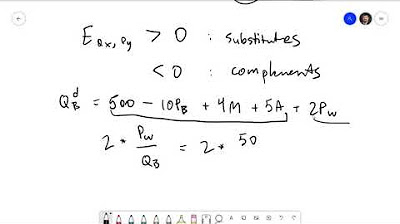Y1 10) Price Elasticity of Demand - PED
TLDRThis video script delves into the concept of price elasticity of demand (PED), explaining how it measures the responsiveness of quantity demanded to price changes. It introduces the PED formula, emphasizing the order of 'quantity demanded' over 'price'. The script uses relatable anecdotes to illustrate the calculation process and interpret PED values, distinguishing between price elastic, inelastic, and perfectly elastic or inelastic scenarios. It also covers factors affecting elasticity, such as availability of substitutes, income percentage, necessity vs. luxury, and time period, providing a comprehensive understanding of PED in economic decision-making.
Takeaways
- 📚 The basic law of demand states that as price increases, quantity demanded decreases, and vice versa.
- 🔍 Price elasticity of demand (PED) measures the responsiveness of quantity demanded to a change in price, using the formula: PED = (% change in quantity demanded) / (% change in price).
- 🧐 Remember to place quantity demanded before price in the PED formula, emphasizing 'Q' before 'P'.
- 🤔 The PED calculation involves converting raw numbers to percentage changes, which is the difference between two numbers divided by the original number, multiplied by 100.
- ⚠️ PED is always negative due to the law of demand, but the negative sign can be ignored when interpreting the final number.
- 📈 If PED is greater than 1, demand is price elastic, meaning a given price change results in a larger proportionate change in quantity demanded.
- 📉 If PED is less than 1, demand is price inelastic, indicating a smaller proportionate change in quantity demanded relative to price changes.
- 💲 PED equals 0 in the case of perfectly price inelastic demand, where quantity demanded does not change regardless of price changes.
- 🔄 PED equals infinity for perfectly price elastic demand, where even a small price change results in an infinitely large change in quantity demanded.
- 🛋️ An example given in the script is the price of a sofa, where a 20% decrease in price leads to a 90% increase in quantity demanded, indicating price elasticity.
- 🚬 Another example is cigarettes, where a 25% increase in price results in a 10% decrease in quantity demanded, showing price inelasticity.
Q & A
What is the basic law of demand?
-The basic law of demand states that as the price of a good or service increases, the quantity demanded decreases, and vice versa.
What is Price Elasticity of Demand (PED)?
-Price Elasticity of Demand (PED) measures the responsiveness of the quantity demanded to a change in the price of a good or service.
How is the PED calculated?
-PED is calculated using the formula: PED = (% Change in Quantity Demanded) / (% Change in Price), with quantity demanded on the top and price on the bottom.
Why is the negative sign in PED calculations not important?
-The negative sign in PED calculations is not important because it's a result of the basic law of demand and can be ignored when interpreting the elasticity of demand.
What does a PED value greater than 1 indicate?
-A PED value greater than 1 indicates that demand is price elastic, meaning that a given price change will result in a proportionately larger change in quantity demanded.
What does a PED value less than 1 indicate?
-A PED value less than 1 indicates that demand is price inelastic, meaning that a change in price will result in a proportionately smaller change in quantity demanded.
What is perfectly price inelastic demand?
-Perfectly price inelastic demand occurs when the quantity demanded does not change at all regardless of the price change, represented by a PED value of 0.
What is perfectly price elastic demand?
-Perfectly price elastic demand occurs when the quantity demanded changes infinitely in response to a price change, represented by a PED value of infinity.
What does a unit price elastic demand mean?
-A unit price elastic demand, indicated by a PED value of 1, means that the percentage change in quantity demanded is equal to the percentage change in price.
How can you determine if demand is price elastic or inelastic based on the number of substitutes available?
-Demand is more price elastic when there are more substitutes available, and more price inelastic when there are fewer substitutes.
What is the relationship between the percentage of income a price change takes and the price elasticity of demand?
-The greater the percentage of income a price change takes, the more price elastic the demand is likely to be, and vice versa.
How does the nature of a good as a luxury or necessity affect its price elasticity of demand?
-Luxuries tend to have more price inelastic demand, while necessities have more price elastic demand because consumers are less sensitive to price changes for essential goods.
What is the impact of addiction on the price elasticity of demand for a good?
-If a good is addictive, demand is likely to be price inelastic because the quantity demanded may not decrease significantly even when the price increases.
How does the time period affect the price elasticity of demand?
-In the short run, demand is often more price inelastic due to fewer available substitutes and less time for consumers to find alternatives. In the long run, demand becomes more price elastic as more substitutes become available.
Outlines
📉 Understanding Price Elasticity of Demand
This paragraph introduces the concept of price elasticity of demand (PED), which measures the responsiveness of quantity demanded to a change in price. The formula for PED is presented as the percentage change in quantity demanded over the percentage change in price, with a reminder to place quantity before price in the calculation. The paragraph humorously uses the mnemonic 'queue before you pee' to help remember the order. It explains that PED can be negative, reflecting the inverse relationship between price and quantity demanded, but the sign itself is not crucial for interpretation. The paragraph then describes how PED values greater than 1 indicate price elasticity, less than 1 indicate price inelasticity, and exactly 1 indicate unit price elasticity. It concludes with an example calculation for cigarettes, demonstrating how to interpret the results as price inelastic.
📈 Drawing Demand Curves and Factors Affecting Elasticity
The second paragraph delves into how to represent demand curves based on the elasticity of demand. It explains that price inelastic demand is associated with a steep demand curve, indicating that changes in price result in proportionately smaller changes in quantity demanded. Conversely, price elastic demand is represented by a shallow demand curve, showing a greater proportionate change in quantity demanded for any price change. The paragraph uses the mnemonic 'SPLAT' to remember factors influencing elasticity: the availability of substitutes, the percentage of income affected by the price change, whether the good is a luxury or necessity, the level of addiction to the good, and the time period considered (short-run vs. long-run). It emphasizes the importance of understanding these factors for businesses, especially in relation to total revenue, and teases the next video's content on this topic.
Mindmap
Keywords
💡Law of Demand
💡Price Elasticity of Demand (PED)
💡Percentage Change
💡Inelastic Demand
💡Elastic Demand
💡Unit Elastic Demand
💡Perfectly Inelastic Demand
💡Perfectly Elastic Demand
💡SPLAT
💡Substitutes
Highlights
The basic law of demand states that as price increases, quantity demanded decreases, and vice versa.
Price elasticity of demand (PED) measures the responsiveness of quantity demanded to a change in price.
PED is calculated as the percentage change in quantity demanded over the percentage change in price.
The formula for PED is important to remember, with quantity demanded on top and price on the bottom.
A mnemonic 'queue before you pee' is used to remember the order of PED formula.
Percentage change is calculated by the difference between two numbers, divided by the original, times 100.
PED will always be negative due to the law of demand but the negative sign can be ignored for interpretation.
If PED is greater than 1, demand is price elastic, indicating a larger proportionate change in quantity demanded relative to price change.
If PED is less than 1, demand is price inelastic, meaning quantity demanded changes less proportionately than the price.
PED equals 0 indicates perfectly price inelastic demand, and PED equals infinity indicates perfectly price elastic demand.
PED equals 1 indicates unit price elasticity, where price and quantity demanded change proportionately.
An example calculation is provided for the price of cigarettes, showing a 25% increase in price and a 10% decrease in quantity demanded, resulting in price inelastic demand.
Another example with sofas shows a 20% decrease in price and a 90% increase in quantity demanded, indicating price elastic demand.
Demand curves are drawn steep for price inelastic goods and shallow for price elastic goods.
The mnemonic 'SPLAT' helps remember factors affecting price elasticity: substitutes, percentage of income, luxury vs. necessity, addictiveness, and time period.
The number of substitutes available affects price elasticity, with more substitutes leading to more price elastic demand.
The percentage of income affected by a price change influences elasticity, with a larger impact leading to more price elastic demand.
Luxuries tend to have more price inelastic demand compared to necessities.
Addictive goods like cigarettes and alcoholic drinks tend to have price inelastic demand due to lower quantity reduction despite price increases.
In the short run, demand is generally more price inelastic due to fewer available substitutes and less time to find alternatives.
In the long run, demand becomes more price elastic as more substitutes become available.
Transcripts
5.0 / 5 (0 votes)
Thanks for rating:





